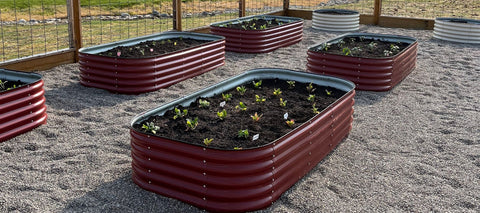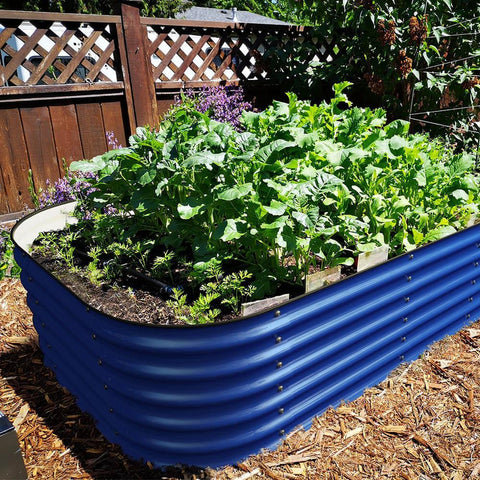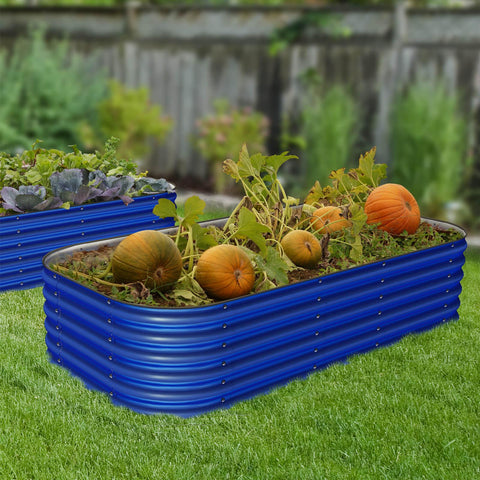The Ultimate Guide to Seasonal Gardening: Tips for Year-Round Outdoor Gardening in Raised Beds
Are you ready to take your gardening skills to the next level? With raised garden beds, you can create a thriving outdoor garden that's not only beautiful but also highly productive. Whether you're a seasoned gardener or just starting out, this ultimate guide to seasonal gardening in raised beds will provide you with all the tips and tricks you need to achieve year-round success. From spring to winter, we'll explore the unique challenges and opportunities each season presents, along with specific strategies for adapting to changing weather patterns. So let's dig in and learn how to make the most of your raised bed garden!
Spring Gardening in Raised Beds
Spring is an exciting time for gardeners as the world comes alive with vibrant colors and fresh growth. In raised bed gardens, the season offers unique advantages that can help you jumpstart your outdoor gardening. Here are some tips to make the most of spring in your raised bed garden:
1. Prepare Your Raised Beds
Before planting, it's important to prepare your raised beds for the upcoming growing season. Start by clearing any debris or weeds from the beds and loosening the soil with a garden fork or rake. This will improve drainage and create a loose, fertile environment for your plants. If needed, amend the soil with compost or organic matter to provide essential nutrients.
2. Choose the Right Plants
When selecting plants for your spring garden, consider those that thrive in cooler temperatures and have shorter growing seasons. Some popular choices include leafy greens like lettuce, spinach, and kale, as well as cool-season vegetables like peas, carrots, and radishes. Flowers like pansies and violas also add a splash of color to your raised bed garden.
3. Start Seeds Indoors
If you want to get a head start on the growing season, start seeds indoors and transplant them into your raised beds once the weather warms up. This allows you to extend your growing season and gives your plants a stronger start. Be sure to provide adequate lighting and maintain proper temperature and humidity levels for successful seed germination.
4. Protect Your Plants
Spring weather can be unpredictable, with temperature fluctuations and occasional frost. To protect your plants from cold snaps, cover them with row covers or cloches. These protective coverings can shield your plants from frost and create a mini-greenhouse effect, keeping them warm and safe.
5. Maintain Adequate Moisture
Spring showers may provide some moisture for your raised garden bed, but it's important to monitor soil moisture levels and water as needed. Raised beds tend to drain more quickly than traditional gardens, so regular watering is essential. Mulching around your plants can help retain moisture and prevent weed growth.

Summer Gardening in Raised Beds
Summer is the time when your raised bed garden will truly shine. With longer days and warmer temperatures, your plants will thrive and produce abundant harvests. Here are some tips to make the most of summer in your raised bed garden:
1. Provide Shade and Air Circulation
As temperatures rise, it's crucial to provide shade and proper air circulation for your plants. Consider installing shade cloth or using structures like trellises or arbors to provide relief from the intense sun. This will prevent your plants from wilting or getting sunburned and help maintain optimal growing conditions.
2. Water Regularly
With increased heat and evaporation, your raised bed garden will require more frequent watering during the summer months. Water deeply and consistently to ensure that the roots receive adequate moisture. Consider using a drip irrigation system or soaker hoses to deliver water directly to the roots and minimize water loss through evaporation.
3. Mulch, Mulch, Mulch!
Mulching is a game-changer in summer gardening. Apply a thick layer of organic mulch, such as straw or wood chips, around your plants to conserve soil moisture, suppress weed growth, and regulate soil temperature. Mulch also adds organic matter to the soil as it breaks down, improving its fertility and structure.
4. Practice Companion Planting
Companion planting is a technique where you grow compatible plants together to maximize their growth potential and deter pests. In raised bed gardens, companion planting becomes even more important as plants are grown in close proximity. For example, planting marigolds around your tomatoes can help repel pests and improve overall plant health.
5. Harvest Regularly
Summer is the time to enjoy the fruits of your labor. Harvest your crops regularly to encourage continuous production and prevent your plants from becoming overcrowded. Be sure to harvest vegetables when they are at their peak ripeness for the best flavor and nutritional value.

Fall Gardening in Raised Beds
Fall is a transitional season in the garden, where you can prepare for the colder months ahead and even extend your growing season. In raised bed gardens, fall offers unique opportunities for planting and preparing your garden for winter. Here are some tips to make the most of fall in your raised bed garden:
1. Plant Cool-Season Crops
Fall is the perfect time to plant cool-season crops that thrive in cooler temperatures. Leafy greens like lettuce, kale, and Swiss chard, as well as root vegetables like carrots and beets, can be planted in your raised beds for a late-season harvest. These crops can withstand light frosts and continue to grow well into the fall.
2. Protect Your Garden
As temperatures drop, it's important to protect your raised bed garden from frost and cold winds. Cover your crops with row covers or frost blankets to provide insulation and prevent damage. Consider using cold frames or mini-greenhouses to create a controlled environment for delicate plants.
3. Clean Up and Prepare for winter
Before winter arrives, clean up your raised beds by removing any spent plants, weeds, or debris. This will help prevent the spread of diseases and pests. Consider adding a layer of compost or organic matter to replenish nutrients and improve soil fertility for the next growing season.
4. Plan for Spring Planting
Fall is also a great time to start planning for your spring garden. Take note of what worked well in your raised beds and make a list of any changes or improvements you want to make for the next season. Consider rotating your crops to prevent soil-borne diseases and plan for any new additions or expansions to your garden.
5. Extend Your Growing Season
To extend your growing season even further, consider using season-extending techniques like hoop houses or cold frames. These structures can trap heat and protect your plants from frost, allowing you to continue growing well into the winter months.

Winter Gardening in Raised Beds
Winter gardening in raised beds is all about maintenance and preparation for the upcoming spring season. While outdoor gardening may be limited during this time, there are still ways to care for your raised beds and ensure a successful growing season ahead. Here are some tips for winter gardening in raised beds:
1. Protect Your Raised Beds
During the winter months, it's important to protect your raised beds from harsh weather conditions. Consider covering them with a layer of mulch or straw to insulate the soil and prevent freezing. This will help protect the roots of your plants and maintain soil fertility.
2. Plan and Prepare
Winter is the perfect time to plan and prepare for the upcoming spring season. Take stock of your garden tools, seeds, and supplies, and make a list of any needed replacements or additions. Use this time to research new plant varieties and gardening techniques that you want to try in the coming year.
3. Improve Soil Health
Winter is also an ideal time to improve the health of your soil. Consider adding organic matter, such as compost, to your raised beds to replenish nutrients and improve soil structure. This will provide a nutrient-rich environment for your plants in the spring and promote healthy growth.
4. Monitor Moisture Levels
Although outdoor gardening may be limited during the winter months, it's still important to monitor moisture levels in your raised beds. Check the soil regularly and water as needed to prevent it from becoming too dry or waterlogged. Proper moisture balance is essential for the health of your plants.

5. Protect Perennials and Overwintering Plants
If you have any perennial plants or overwintering crops in your raised garden beds, take steps to protect them from freezing temperatures. Consider using frost blankets or row covers to provide insulation and prevent damage. Mulching around the base of plants can also help protect their roots from freezing.
With the knowledge and strategies provided in this ultimate guide to seasonal gardening in raised beds, you're well-equipped to create a thriving outdoor garden that can be enjoyed year-round. From spring to winter, each season presents unique opportunities and challenges for outdoor gardening. By following the tips and techniques outlined in this guide, you can adapt to changing weather patterns, maximize your harvests, and create a beautiful and productive raised bed garden. So roll up your sleeves, grab your gardening tools, and get ready to experience the joys of year-round outdoor gardening in raised garden beds!
